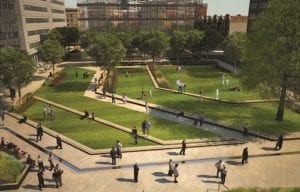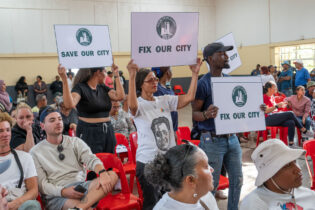The engineering principles for creating ‘green’ buildings are both well understood and have been widely applied. Nicholas McDiarmid, asks: where to from here?
“We have earned our Stars in the art of green design, literally, and while innovation will continue to make further advances, our focus is shifting to ensuring sustainability in the face of almost overwhelming urbanisation,” says Aurecon’s national green buildings expert, Martin Smith. “We’re entering a new age of green design that explores the development of sustainable precincts in large cities and urban areas,” comments Marni Punt, environmentally sustainable design consultant and landscape architect at Aurecon. “This means moving outside of the more traditional engineering ‘comfort zone’ that entails designing and constructing an environmentally sound building, to collaborating with a wide range of organisations and competencies to address socio-economic issues and the ‘liveability’ of an environment.” In this article, Smith and Punt attempt to define this latest wave of thinking, explore how to achieve greener precincts and discuss the rating tools that are being developed to add value to the precinct concept. Defining the conceptThe rapid growth in population and increased urbanisation of countries throughout the world creates both a challenge and an opportunity to learn from the failures and success of urban design to create smarter, more efficient, and more liveable communities. The concept of sustainable precincts is still evolving. It merges the design of sustainable buildings, urban design and infrastructure.
“Sustainable communities help people lead more sustainable, healthy and connected lives,” explains Smith. Sustainable precincts present a range of benefits to stakeholders and affected communities throughout their life cycles, from providing safe, attractive facilities and a healthy living environment to contributing to diverse, vibrant and evolving communities. “Sustainable precincts suggest more than just environmentally-friendly buildings. They enable a lifestyle choice that enhances quality of life for residents and can be used as a market differentiation strategy by investors who wish to gain a competitive advantage within the bourgeoning market that is environmentally-conscious construction,” says Smith. In Australia, the Green Building Council of Australia’s (GBCA) Green Star Communities National Framework rating tool has established five principles on which to shape the evolution of new, and revitalisation of existing, sustainable communities. The principles test a precinct project by asking whether it: • enhances liveability
• creates opportunities for economic prosperity
• fosters environmental quality
• embraces design excellence
• demonstrates visionary leadership and strong governance? The tool provides detailed metrics under each of the above principles to shape and benchmark the development of new communities or the enhancement and ‘retro-fitting’ of existing communities. In addition, South Africa is pioneering broader economic and social performance criteria that considers challenges such as the alleviation of poverty, unemployment and poor health, in addition to more traditional environmental issues related to green building, through the Green Building Council of South Africa’s (GBCSA) pilot socio-economic category (SEC) for Green Star South Africa’s rating tools. This tool is currently being tested across several construction projects and has advanced beyond traditional green building criteria to assess the social and economic elements of construction projects, and how these contributed to broader sustainability and poverty alleviation objectives. Achieving greener precincts
Developing sustainable communities starts by seeking to embed sustainable design principles into the way in which streets, parks and buildings are laid out. It is the spaces between buildings that determine the liveability and value of a community and good planning and urban design are the fundamental building blocks of a sustainable community. Creating places for people is the key ingredient in designing successful and thriving communities. This must include places for people to work, rest and play, with high-quality urban design connecting smart and sustainable buildings. • Passive design as central to greening
In principle, the buildings within a sustainable precinct should be resilient and adaptable to the ever-changing natural environment. We can save money and enhance value if we can orientate the streets and buildings to take best advantage of solar orientation and prevailing winds. This principle has been known since the start of architecture, but it is often ignored in the design of our cities. From an energy viewpoint, this can be achieved through the universal application of passive design. Buildings designed using solar design principles use the sun to heat them in the winter whilst they exclude the heat of the sun in summer, using insulation and shading. Passive solar buildings require only 10% of the energy used by conventional buildings. The ‘father of architecture’, Vitruvius, wrote over 2 000 years ago that the first step in successful town planning is to identify the major winds and from which direction these come and then mark the centre of the city accordingly. Cold winds are disagreeable to man and are to be avoided. Likewise, hot and humid winds are unhealthy. All roads are to be laid out on an axis between two quarters so that the winds will be funnelled down the streets and alleyways. The laying out of roads in this manner also prevents winds from blowing head on into the facades of the buildings lining the streets, and thus keeps the winds out of the dwelling spaces. We can now use sophisticated precinct modelling tools to enhance our fundamental design knowledge of climate, topography and environment and seek to optimise the design of our communities.
In addition, with the rapidly falling price of photovoltaic (PV) panels, we are seeing wide spread take up of this technology by households. Over one million homes in Australia are providing for a significant amount of the power they need using PV panels installed on their roofs, and this number is expected to grow
• Precinct energy systemsFor some high density communities, it makes good economic sense to look beyond servicing buildings using standalone electricity, heating and cooling systems and to provide these using centralised precinct energy systems via co-generation and trigeneration systems with district heating and cooling that is monitored and controlled by a precinct wide smart grid. In addition, communities can use their collective buying power to drive down the cost of installing PV panels – there are many examples of this in Australia. Water management, on a precinct scale, should aim to create a balance between water risk and allocation through water-sensitive urban design. Sustainability can be achieved on three levels:
• by installing infrastructure for the efficient collection, treatment and distribution of the various water systems
• by having an active management system for the infrastructure that is able to optimise water balances between different uses
• through educating and motivating communities to maintain water services. Driven by the sheer scale of urbanisation, there is also a necessity and considerable scope for innovative waste management. While waste-to-energy initiatives are a viable method of waste management, Smith suggests that sustainable precincts will benefit more from strategies that prevent waste rather than for disposing or recycling it. On a precinct level, a recent innovation that breaks out of the mindset of refuse collection vehicles is the development of automatic waste collection systems (AWCS), or pneumatic collection systems, which are able to transport refuse through a vacuum in underground pipes to a central waste handling facility. This enhances the liveability of the local community whilst reducing the energy used in waste collection and disposal and makes recycling easier. • Liveability and walkability criteria
Within precincts, the emphasis often lies on ‘liveability’ and ‘walkability’. Interestingly, ways of evaluating the value of the activity walking and walkability – the quality, safety, comfort and convenience of being able to walk in a precinct – have been developed (Litman, 2011). The contention with walkability is that walking is an important but underestimated component of all people transport systems and should be addressed, rather than purely focusing on faster, cleverer motorised movement. Precincts that are conducive to walking are conducive to people and walkability carries the extra rewards of being greener, healthier and a significant contributor to liveability. Competing for ‘Stars’ – precinct rating tools
“Rating and certification systems have become a helpful point of reference when it comes to green design, as they help define the market and remove subjectivity from green developments,” says Punt. There are various rating tools that are being developed with a specific focus on sustainable precinct design. In addition to the recent Green Star Communities National Framework rating tool, and the socio-economic Category for Green Star South Africa, other initiatives include the Building Research Establishment Environmental Assessment Method, Leadership in Energy and Environmental Design for Neighbourhood Development and the One Planet Living scheme, which will soon be widely adopted in South Africa. Stakeholder motivation will shape the way forward
“The value of sustainable precincts cannot necessarily be defined in financial terms,” says Smith. He goes on to say that investment and input from governments and private stakeholders will be vital in ensuring the successful integration of these precincts into existing areas whether through revitalisation, renovation or retrofitting. Smith further predicts that fast-developing, sustainable precincts will gain popularity and traction globally over the next few years. He adds that current business systems and organisational processes that are continually focused on least-cost, ‘business-as-usual’ infrastructure development can prove extremely challenging to the development of sustainable precincts. “Despite inevitable challenges, the benefits of the development of sustainable precincts remain evident,” claims Punt. “Greening on a precinct and city scale will allow the construction industry and government to deliver large-scale socio-economic priorities such as energy security, job creation, social stability and effective resource management, as well as the mitigation of climate change.” Designing smart, sustainable communities makes good business sense because it has already been seen that people and businesses are looking for safe and liveable places to live, work and play, with good quality urban design and buildings. Furthermore, by embedding these principles of good design right from the start we can also make them affordable communities. “As with many modern design initiatives, sustainable precincts require the right amount of investment from stakeholders,” concludes Smith. “The engineering industry has the capability and thrives on innovation, but we need investors to champion the cause of creating more liveable, desirable places for people to live.” Litman, T. 2011. Economic value of walkability. Victoria Transport Policy Institue.








